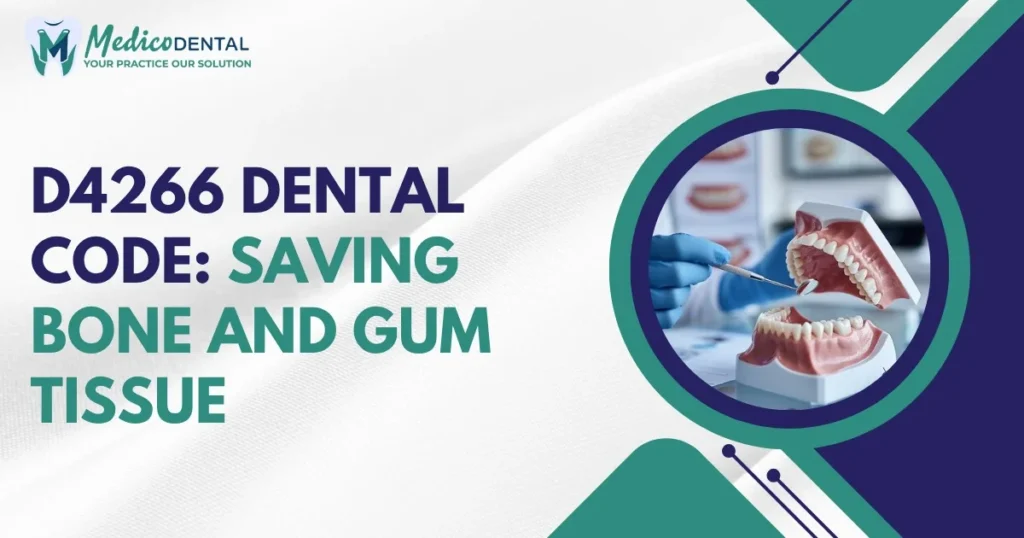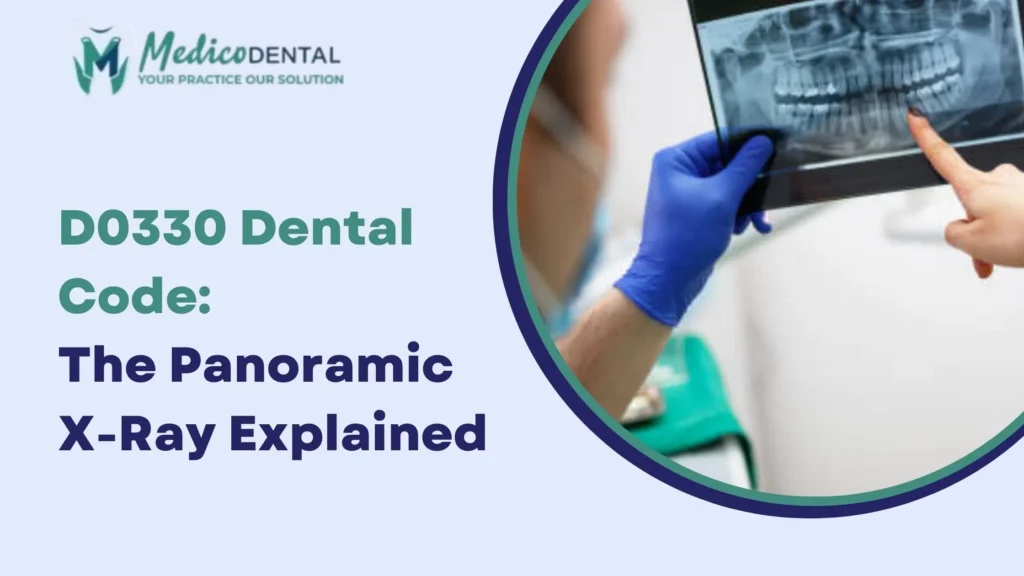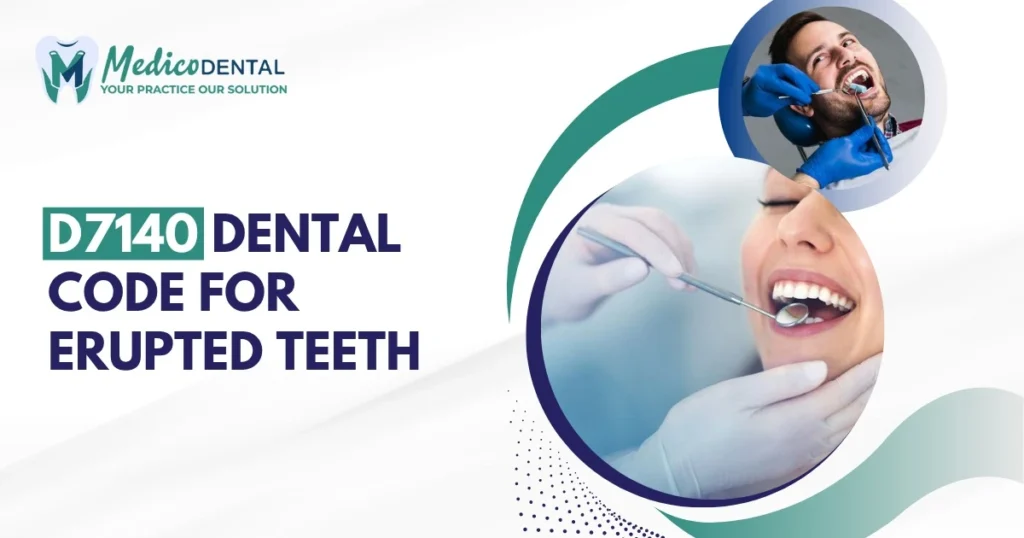The D4266 Dental Code refers to “Guided Tissue Regeneration – Resorbable Barrier, Per Site.”
This Current Dental Terminology (CDT) code is defined by the American Dental Association (ADA) and is used to describe a periodontal surgical procedure that promotes the regrowth of bone and supporting tissues lost due to gum disease or trauma.
In this procedure, a resorbable (biodegradable) membrane is placed to guide the natural regeneration of gum and bone tissues. Unlike non-resorbable materials, this barrier dissolves over time, eliminating the need for a second surgery.
Why Guided Tissue Regeneration Matters in Periodontal Treatment
Guided tissue regeneration (GTR) is a key innovation in periodontal therapy because it helps preserve natural teeth and restore lost bone structures.
When periodontal disease destroys bone support around a tooth, normal healing often fails to restore it naturally. The resorbable barrier used in GTR acts as a selective filter, keeping unwanted soft tissue cells out while allowing bone-forming cells to repopulate the area.
For patients, this means:
- Reduced risk of tooth loss
- Better long-term gum stability
- Faster, less invasive healing compared to non-resorbable barriers
For dental professionals, using D4266 ensures accurate coding for this advanced regenerative treatment.
Description and Purpose of D4266
ADA Definition and Clinical Meaning
According to the ADA’s CDT manual, D4266 is defined as:
“Guided tissue regeneration – resorbable barrier, per site.”
It describes the placement of a biodegradable membrane used to promote new tissue growth in the treatment of periodontal bone defects.
The procedure focuses on regenerating lost periodontal structures such as bone, ligament, and cementum.
Primary Purpose of the D4266 Procedure
The main goal of D4266 is to:
- Restore bone support around teeth affected by periodontal disease
- Protect grafted or healing areas from soft tissue interference
- Facilitate long-term regeneration and tooth stability
By using a resorbable barrier, the dentist avoids the need for a second surgery to remove the membrane—an important advantage for patient comfort and healing.
When Dentists Use the D4266 Code
Dentists typically report D4266 when performing:
- Guided tissue regeneration in periodontal bone defects
- Procedures involving resorbable barrier membranes
- Regenerative treatments not involving bone grafts (unless billed separately)
It is coded per site, meaning if multiple teeth or areas are treated, each site should be billed individually.
Step by Step Procedure Overview
Pre Operative Preparation
Before the procedure, the dentist performs:
- Full periodontal examination and probing
- Radiographs to identify bone loss and defect shape
- Scaling and root planing (if necessary)
- Discussion with the patient about treatment goals and insurance coverage
Proper case selection ensures that only defects with regenerative potential are treated with D4266.
Cleaning and Debridement of the Affected Area
The dentist surgically exposes the defect and thoroughly removes:
- Plaque
- Calculus (tartar)
- Granulation tissue
This cleaning process is crucial because the success of guided tissue regeneration depends on a sterile and well-prepared site.
Placement of the Resorbable Barrier Membrane
Once the defect is debrided, the dentist carefully places a resorbable membrane over the bone defect.
This barrier:
- Separates the gum tissue from the bone defect
- Prevents soft tissue from filling the space
- Encourages bone and ligament cells to regenerate
Common materials include collagen-based or synthetic biodegradable membranes.
Healing and Regeneration Process
After placement, the site is sutured and allowed to heal.
Over several months:
- The barrier membrane gradually dissolves
- New bone and tissue begin to form in the protected area
- The dentist monitors healing through follow-up visits and radiographs
Indications for Using D4266 Dental Code
Periodontal Bone Defects
D4266 is ideal for intrabony or furcation defects caused by chronic periodontitis.
These defects, if untreated, can lead to tooth mobility and eventual loss. GTR helps restore the lost bone around the tooth root.
Bone Grafting Cases
When used with a bone graft, D4266 acts as a protective barrier that stabilizes the graft material and guides the healing process.
However, bone graft placement is coded separately (typically D3432).
Implant Placement Support
In some cases, dentists use guided tissue regeneration to prepare bone structure before or after implant placement, ensuring proper bone density and support.
Other Clinical Scenarios
- Gingival recession treatment (select cases)
- Regeneration after cyst removal or trauma
- Periodontal regeneration around previously compromised teeth
Exclusions and Related Codes
When Not to Use D4266
Do not use D4266 when:
- A non-resorbable barrier is used (report D4267)
- The membrane is placed for implant-related bone regeneration (see D6106 or D7956)
- The treatment involves wound dressings or bone grafts only
D4267 – Non-Resorbable Barrier Membrane
If the dentist uses a non-resorbable barrier, the correct code is D4267.
This procedure often requires a second surgery to remove the membrane after healing.
D3432 – Bone Grafting Material Placement
When a bone graft is performed alongside tissue regeneration, code D3432 is used in addition to D4266 (if both are performed in the same site).
D7922 – Wound Dressings
For cases involving surgical dressings or protective coverings, report D7922, not D4266.
Billing and Coding Guidelines
How to Bill for D4266 Per Site
- Report D4266 for each site where a resorbable barrier membrane is placed.
- Each tooth or defect counts as a separate site.
- Include detailed chart notes and radiographs showing the defect.
For example:
If the dentist treats three separate periodontal sites, bill D4266 × 3.
Documentation Requirements for Claims
Strong documentation helps prevent denials. Include:
- Diagnosis of periodontal disease with pocket depth
- Pre- and post-operative radiographs
- Narrative description of the defect and membrane placement
- Type of membrane used and its resorbable nature
Common Claim Denials and How to Avoid Them
Insurance claims for D4266 are often denied due to:
- Lack of supporting radiographs
- Missing periodontal charting
- Not specifying “resorbable membrane” in the notes
Avoid these by providing comprehensive clinical narratives and clear documentation of medical necessity.
Importance of Narrative and Clinical Justification
An effective narrative might look like:
“Guided tissue regeneration performed using a resorbable collagen membrane over a 3-wall intrabony defect on #30 distal. Purpose: to prevent epithelial downgrowth and promote bone regeneration.”
Such details strengthen reimbursement chances and compliance with payer requirements.
Insurance Coverage and Reimbursement Tips
Factors Affecting Coverage
Coverage for D4266 varies by plan. Factors include:
- The severity of periodontal disease
- Whether bone loss is documented radiographically
- Type of insurance (PPO vs HMO)
- Frequency limitations for periodontal procedures
Pre-Authorization and Verification Steps
Before performing the procedure:
- Submit x-rays and periodontal charting for pre-authorization.
- Confirm whether the plan covers guided tissue regeneration.
- Obtain written confirmation to avoid claim delays.
Medical Necessity and Supporting Evidence
To ensure approval:
- Clearly link the procedure to periodontal bone loss or tooth stability
- Use terminology like “intrabony defect,” “bone regeneration,” or “loss of attachment.”
- Provide post-op documentation showing clinical improvement.
Common Clinical Questions About D4266
How Long Does the Barrier Take to Resorb?
The resorption period of the barrier membrane used in D4266 varies depending on the material and manufacturer.
Typically, resorbable membranes dissolve within 4 to 6 months, although some may last longer to provide extended protection during bone regeneration.
Common materials include:
- Collagen-based membranes: These are biocompatible and break down naturally within 3–6 months.
- Synthetic polymers (PLGA or PGA): These may take slightly longer, up to 9 months.
During this time, the barrier supports the regeneration of bone and periodontal ligament while preventing epithelial tissue from invading the defect.
Dentists should always note the type and brand of the membrane in clinical records for accurate documentation and potential audit review.
Can D4266 Be Used with Bone Grafts?
Yes the D4266 procedure can absolutely be combined with bone grafts, but each must be billed and documented separately.
The barrier membrane (D4266) serves as a protective layer that covers the bone graft, stabilizing it and guiding new bone formation.
When both are performed:
- Report D4266 for the membrane placement
- Report D3432 (or applicable graft code) for the bone graft itself
It’s critical to include clear clinical notes and radiographs showing both the defect area and graft placement.
This distinction helps insurers recognize that two distinct procedures were performed for optimal patient outcomes, minimizing the chance of claim denials.
What’s the Difference Between D4266 and D7956?
Although both D4266 and D7956 involve tissue regeneration, they serve different clinical purposes:
| Aspect | D4266 – Guided Tissue Regeneration | D7956 – Guided Bone Regeneration (for Implants) |
| Primary Focus | Regenerating bone and periodontal tissue around natural teeth | Regenerating bone to support or prepare for dental implants |
| Membrane Type | Resorbable barrier (periodontal use) | Resorbable or non-resorbable (implant site use) |
| Purpose | Treating periodontal bone defects | Building bone for implant stability |
| Billing Category | Periodontal procedure | Implant or oral surgery-related procedure |
In simple terms, D4266 is used when the goal is to save natural teeth, while D7956 supports implant preparation or maintenance.
Using the correct code ensures accurate claim submission and compliance with ADA CDT guidelines.
Best Practices for Dentists and Billing Specialists
Ensuring Accurate Coding and Documentation
Accurate coding for D4266 goes beyond selecting the right CDT number — it requires thorough and precise documentation.
Each claim should include:
- Periodontal charting showing pocket depth and attachment loss
- Pre- and post-operative x-rays illustrating bone loss and defect shape
- A narrative explaining the purpose of the membrane placement
- The membrane brand and resorbable type
Example narrative for accuracy:
“Performed guided tissue regeneration using a resorbable collagen membrane over a 3-wall intrabony defect on #19 distal. Membrane will resorb naturally to promote bone regeneration and prevent soft tissue intrusion.”
Well-written narratives not only justify the procedure but also protect against denials during post-claim audits.
Coordinating with Insurance for Better Reimbursement
Insurance verification plays a vital role in successful reimbursement for D4266. Many plans have specific requirements for periodontal regenerative procedures.
Best practices include:
- Verify coverage in advance: Confirm that guided tissue regeneration is covered and if there are frequency limitations.
- Submit pre-authorizations: Include clinical evidence such as radiographs, pocket depths, and narratives.
- Use correct modifiers or documentation attachments: Some payers may request tooth numbers, surface codes, or per-site detail.
- Stay updated with payer policies: Carriers like Aetna, UHC, and Delta Dental may have unique documentation or time limitations for regenerative procedures.
Consistent communication between the front office, clinician, and billing team ensures smooth claim submission and higher approval rates.
Communicating Procedure Value to Patients
Patients often struggle to understand why a “membrane” procedure is necessary or why it might not be fully covered by insurance.
Dentists should take the time to explain the value and purpose of guided tissue regeneration in simple terms.
You might say:
“This membrane acts as a protective layer that helps your bone and gum tissue grow back naturally. It’s a preventive step to avoid future tooth loss and gum surgery.”
Educating patients improves case acceptance, builds trust, and helps them understand the long term value of regenerative therapy, even when insurance only partially covers the cost.
Key Takeaways
Clinical Importance of D4266
- D4266 represents a critical periodontal regeneration technique for restoring bone and gum health.
- It helps prevent tooth loss and supports natural tissue healing without secondary surgery.
- When properly performed, it contributes to long-term periodontal stability and improved oral health outcomes.
Financial and Coding Considerations
- Always bill per site for D4266 and provide complete documentation, including radiographs and narratives.
- Ensure accurate coding distinctions between D4266 (periodontal GTR) and D7956 (implant-related GBR).
- Verify insurance policies early to avoid delays or denials and maintain steady cash flow for your practice.
Summary of Best Practices
- Document every detail: defect description, membrane type, and treatment rationale.
- Combine D4266 with related codes (like D3432) only when clinically performed and supported.
- Pre-authorize and verify benefits before surgery.
- Communicate with patients clearly about procedure value and coverage expectations.
- Keep your dental billing and clinical teams aligned for consistency and compliance.
Conclusion
Final Thoughts on D4266 Dental Code and Guided Tissue Regeneration
The D4266 Dental Code is more than just a billing identifier it represents one of the most advanced regenerative therapies in modern dentistry.
By understanding how and when to use this code, dental professionals can ensure:
- Better patient outcomes
- Precise clinical documentation
- Optimized reimbursement for periodontal procedures
For dentists, D4266 offers a way to preserve natural teeth, reduce invasive surgeries, and improve periodontal health.
For billing specialists, it highlights the importance of accuracy, compliance, and proactive insurance management.
When used correctly, D4266 reflects both clinical excellence and administrative precision the foundation of a successful, ethical, and patient-centered dental practice.



